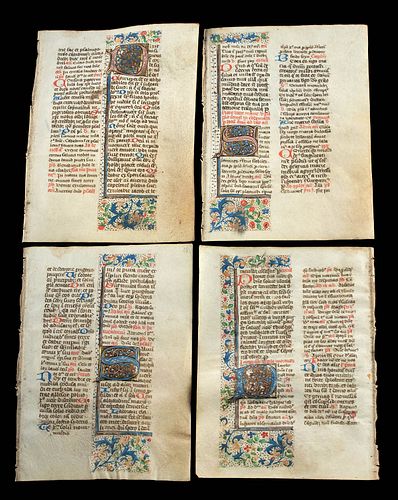Four 15th C. European Illuminated Manuscript Pages
Lot 59
About Seller
Artemis Fine Arts
686 S Taylor Ave, Ste 106
Louisville, CO 80027
United States
Selling antiquities, ancient and ethnographic art online since 1993, Artemis Gallery specializes in Classical Antiquities (Egyptian, Greek, Roman, Near Eastern), Asian, Pre-Columbian, African / Tribal / Oceanographic art. Our extensive inventory includes pottery, stone, metal, wood, glass and textil...Read more
Categories
Estimate:
$4,000 - $6,000
Absentee vs Live bid
Two ways to bid:
- Leave a max absentee bid and the platform will bid on your behalf up to your maximum bid during the live auction.
- Bid live during the auction and your bids will be submitted real-time to the auctioneer.
Bid Increments
| Price | Bid Increment |
|---|---|
| $0 | $25 |
| $300 | $50 |
| $1,000 | $100 |
| $2,000 | $250 |
| $5,000 | $500 |
| $10,000 | $1,000 |
| $20,000 | $2,500 |
| $50,000 | $5,000 |
| $100,000 | $10,000 |
| $200,000 | $20,000 |
About Auction
By Artemis Fine Arts
Mar 24, 2022
Set Reminder
2022-03-24 10:00:00
2022-03-24 10:00:00
America/New_York
Bidsquare
Bidsquare : Exceptional Antiquities Ethnographic Fine Art
https://www.bidsquare.com/auctions/artemis-gallery/exceptional-antiquities-ethnographic-fine-art-9057
Museum-worthy examples of classical antiquities (Egyptian, Greek, Roman, Near Eastern), Viking, Far East / Asian, Pre-Columbian, African / Tribal, Oceanic, Native American, Spanish Colonial, Fossils, Ancient Jewelry, Fine / Visual Arts, so much more! Artemis Fine Arts info@artemisgallery.com
Museum-worthy examples of classical antiquities (Egyptian, Greek, Roman, Near Eastern), Viking, Far East / Asian, Pre-Columbian, African / Tribal, Oceanic, Native American, Spanish Colonial, Fossils, Ancient Jewelry, Fine / Visual Arts, so much more! Artemis Fine Arts info@artemisgallery.com
- Lot Description
Western Europe, probably France, ca. 15th century CE. A beautiful ensemble of 4 exquisite, double-sided vellum manuscript pages from an illuminated Book of Hours manuscript, all skillfully penned and illustrated by hand in hues of scarlet, cobalt, emerald, yellow, pink, black, and white and adorned with lustrous gilt details. Each page features 2 columns of Latin script on each side, featuring enlarged, illuminated initial capitals and decorative borders of polychrome floral and foliage motifs. Judging from their similar stylistic approach of each page, these leaves appear to be from the same book. While it is common practice to separate old books into individual pages for sale, how fortunate are we to have this ensemble grouped together! Like many illuminated manuscripts, each page serves as a breathtaking work of art with a finely balanced layout, enriching use of color, masterful decoration, and painstakingly delineated calligraphic script. Size (all the same): 4" W x 5.6" H (10.2 cm x 14.2 cm)
These pages come from a Book of Hours, a Christian devotional book that usually included a calendar of church celebrations/feasts, excerpts from the four gospels of Mark, Luke, Mathew, and John, the fifteen Psalms of Degrees, the Little Office of the Virgin Mary, the seven Penitential Psalms, an Office for the Dead, a Litany of Saints, and the Hours of the Cross. The word "manuscript" literally means "written by hand" and comes from the Latin words manus (hand) and scriptus (writing). These books were the creations of several skilled individuals who devoted many hours to their respective tasks. First, the vellum or parchment was created by one person. Then the text was handwritten by a scribe who meticulously wrote every word in ink with a quill pen. Finally, an illuminator (from the Latin illuminaire meaning "lighted up") decorated these books with gold leaf and brilliant color. Such books were made by urban booksellers called libraire during this the Middle Ages and the Renaissance, and were created in literary centers such as Paris, Bruges, Ghent, or Valenciennes. The production of illuminated manuscripts continued in earnest until the mass production of books was made possible by Johannes Gutenberg's invention of moveable type and the printing press. Books like these were prized objects, often given as gifts to commemorate important occasions. An unquestionably precious ensemble of illuminated manuscript pages replete with artistry, refined technique, and iconography apropos to this intensely religious period.
Provenance: private East Coast, USA collection
All items legal to buy/sell under U.S. Statute covering cultural patrimony Code 2600, CHAPTER 14, and are guaranteed to be as described or your money back.
A Certificate of Authenticity will accompany all winning bids.
PLEASE NOTE: Due to recent increases of shipments being seized by Australian & German customs (even for items with pre-UNESCO provenance), we will no longer ship most antiquities and ancient Chinese art to Australia & Germany. For categories of items that are acceptable to ship to Australia or Germany, please contact us directly or work with your local customs brokerage firm.
Display stands not described as included/custom in the item description are for photography purposes only and will not be included with the item upon shipping.
#164528All are pages from a larger book. Slight wear to edges, especially edge that was previously attached to binding. Lightly penciled numbers on upper right corner of each. Minor areas of staining, commensurate with age. Otherwise, all are excellent and highly readable with bright artwork. All have removable film covers for protection.Condition
- Shipping Info
-
All shipping is handled in-house for your convenience. Your invoice from Artemis Gallery will include shipping calculation instructions. If in doubt, please inquire BEFORE bidding for estimated shipping costs for individual items.
-
- Buyer's Premium



 EUR
EUR CAD
CAD AUD
AUD GBP
GBP MXN
MXN HKD
HKD CNY
CNY MYR
MYR SEK
SEK SGD
SGD CHF
CHF THB
THB
















